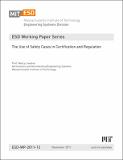| dc.contributor.author | Leveson, Nancy G. | |
| dc.date.accessioned | 2016-06-02T14:53:36Z | |
| dc.date.available | 2016-06-02T14:53:36Z | |
| dc.date.issued | 2011-11 | |
| dc.identifier.uri | http://hdl.handle.net/1721.1/102833 | |
| dc.description.abstract | Certification of safety-critical systems is usually based on evaluation of whether a system or product reduces risk of specific losses to an acceptable level. There are major differences, however, in how that decision is made and on what evidence is required. The term Safety Case has become popular recently as a solution to the problem of regulating safety-critical systems. The term arises from the HSE (Health and Safety Executive) in the U.K., but different definitions seem to be rife. To avoid confusion, this paper uses the term “assurance cases” for the general term and limits the use of the term “safety case” to a very specific definition as an argument for why the system is safe. This paper examines the use of safety cases and regulation in general. The first important distinction is between types of regulation. | en_US |
| dc.language.iso | en_US | en_US |
| dc.publisher | Massachusetts Institute of Technology. Engineering Systems Division | en_US |
| dc.relation.ispartofseries | ESD Working Papers;ESD-WP-2011-13 | |
| dc.title | The Use of Safety Cases in Certification and Regulation | en_US |
| dc.type | Working Paper | en_US |
